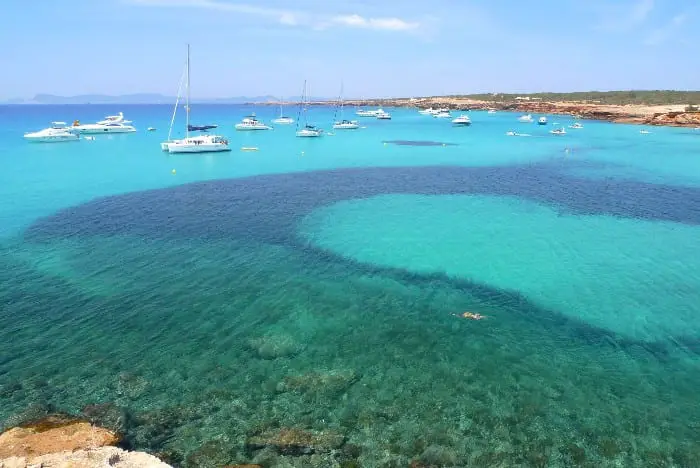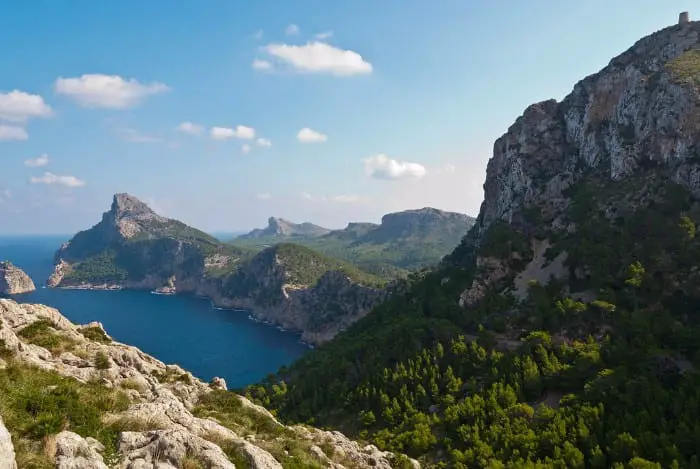Backpacking in the Balearic Islands (Ibiza, Mallorca, Menorca & Formentera)
The Balearic Islands have long been popular holiday destinations, mostly for Northern Europeans looking for a short sunny getaway. Typically people fly in and fly out, only visiting one island but it is possible to do a longer, backpacking trip in the Balearic Islands. You don’t need to break the bank although it is true that some destinations are pricey, certainly by Spanish standards.
Firstly, it’s perhaps wise to dispel a few myths. To many, these islands solely exist for the purpose of holidaymakers but Mallorca alone has a permanent population of nearly a million people and its capital Palma is the 8th largest city in Spain. While urban life isn’t exactly the main draw for visitors, amongst the mania of the party resorts and packed beaches, you can also find plenty of quieter spots, beautiful natural scenery, traditional villages and a surprising amount of history and culture.
It’s also worth noting that in contrast to Spain’s Canary Islands, located just off the coast of Africa, the Balearic Islands do not stay warm all year. Average highs are above 20 degrees centigrade from May to October with the hottest and by far the busiest time of year being July and August. However from roughly mid-November to mid-April it’s generally not beach weather and temperatures fall to below 10°C at night, although days are mostly pleasant.
The archipelago makes up an autonomous community and province of Spain but has strong Catalan roots and both Catalan and Spanish are official languages on the islands which explains why you will see place names spelt differently (Mallorca and Majorca for example). We will try to briefly explain the main differences between the islands below and some tips for getting around which should help you plan a backpacking route for the Balearic Islands.
Formentera

Clear water in Formentera, CC BY 2.0
Formentera is the smallest and least known of the four main Balearic islands, located only a few kilometres south of Ibiza. Only around 8,000 people live there today but it has a fascinating history having been occupied by human life for around 4000 years with the ancient Romans, Byzantines and Arabs amongst those to have ruled the island.
Today visitors are drawn to its sandy, unspoiled beaches and although it has made attempts to limit the influx of tourism, it does still get very busy during July and August as a popular day-trip from Ibiza. It’s a small, flat island which makes cycling and walking popular while snorkelling, sailing and fishing are other ways to spend the day.
Getting to Formentera
As the only one of the four islands without an airport, the only way in is via the sea, with plenty of connections to nearby Ibiza. Ferry tickets to Formentera can also be bought from Barcelona and Denia, the nearest port on the Spanish mainland, which is conveniently located between Valencia and Alicante. If you want to visit all four islands, geographically speaking it may be sensible to start in Formentera and then head to Ibiza, Mallorca and Menorca in that order although you could also do the trip in reverse.
Ibiza

Ibiza is of course most famous for its wild nightlife with several giant night-clubs, a mecca for techno and dance music lovers. Of the four islands, it has the youngest crowd and for party animals, a trip to Ibiza is almost a rite of passage. One thing Ibiza is not though is cheap, with clubs regularly charging in excess of €30 for entry alone while drinks inside are also far more expensive than you’ll find in other parts of the country. A few nights out in Ibiza will quickly eat into any backpacking budget for Spain and you’d be wise to plan on spending more if you’re just visiting the islands.
There is another side to Ibiza though away from the carnage of its main nightlife strips. Ibiza’s old town is a charming little place while the island is small enough that it’s easy to explore at your own leisure with hidden coves and tiny offshore islets adding to the intrigue while Wednesday’s Punta Arabi Hippy Market is another must see.
Getting to Ibiza
For a small island, Ibiza’s airport is pretty sizeable with budget flights to cities all around Europe. If you’re coming from mainland Spain or doing this as an extension to our backpacking route for Spain and Portugal, then flying is likely to still be the cheapest and certainly quickest option but there are boat connections to/from Valencia, Alicante and Barcelona too which can be a nice option for those looking for a Mediterranean adventure.
Mallorca

mountain scenery in Majorca by i-workz on flickr, CC BY-SA 2.0
Mallorca is considerably larger and more populous than the other three islands put together and it really does have a little bit of everything. Most visitors are attracted to its beaches and crystal blue Mediterranean waters. Many of those have been transformed into package holiday resorts, but with a bit of persistence you can still find much quieter ones. If you’re travelling as a group, renting a car is a good idea to really get off the beaten track.
If you want to party, Magaluf is the place to go with its wild clubbing scene mostly targeted at young British visitors. It’s not to everyone’s taste though and you can also have a good night out in Palma which certainly has a more local vibe. For a much quieter experience head to the Serra de Tramuntana, a beautiful mountain range with some stunning views in the North-west of the island, a world away from the beach resorts. The charming village of Valdemossa and numerous caves also make for great afternoon trips.
It’s certainly large enough to do a genuine backpacking-style trip, staying a few nights in different parts of the island to get a taste for the many different sides of Mallorca.
Getting to Mallorca
Mallorca is the easiest of the islands to get to. Its airport is the third biggest in Spain after Madrid and Barcelona and it has a huge selection of budget flights to around Europe, particularly during the summer months. If you’re coming from further afield, it should be very easy to fly into Madrid or Barcelona and take a connecting flight to Palma de Mallorca, which also has a ferry terminal with pretty regular departures to Ibiza and Mahón, the capital of Menorca.
Menorca
Menorca is Mallorca’s little brother, the Eastern-most of the Balearic islands and furthest away from mainland Spain. It is a much quieter place and has a slower pace of life than the others and remains largely unspoiled. Despite its size, it has several of the best beaches in the Balearic Islands and even during the height of summer, you can occasionally strike it lucky and find a whole bay totally deserted.
It’s also an island of pretty harbours, fortresses, museums and sleepy villages so there’s plenty of exploring to be done. Its tranquillity does come at a price though and you won’t find much in the way of budget or hostel-style accommodation on the island so be prepared to fork out a bit more for that than you would certainly in Mallorca, which has a slightly wider choice for budget travellers.
Getting to Menorca
Menorca does have its own airport (Mahon) although it doesn’t receive as many flights as Ibiza or Mallorca. That said, there are still plenty of options from Spain and the UK and from a geographical perspective, it may make sense to either start or end your trip in Menorca and then work your way West to the other three islands. There are also regular ferries to/from Mallorca and mainland Spain.
This article was published in December 2017.
